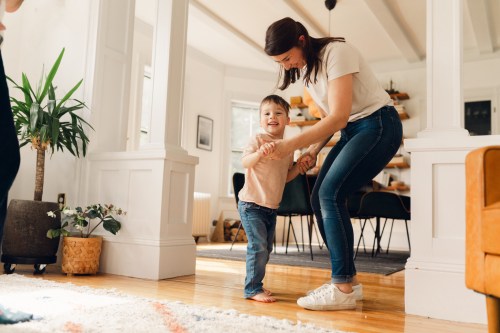Why Parents Fear the Dreaded ‘Sundown Scaries’
The dreaded 'sundown scaries' may cause parenting anxiety during the last hours of the day when anticipation about the night hits.

Night falls, and quiet permeates the house. A cloud moves across the moon, the wind rustles through the trees. All is still—but something approaches. A prowler, a nightmare? No, no. It’s the “sundown scaries,” the anticipatory fear and anxiety that can strike parents in the evening before bed. Conversation has been churning on social media, with a handful of TikToks about “sundown scaries” garnering hundreds of thousands of views. The videos, and many of the comments, bemoan how little people talk about the phenomenon when it is apparently so common. Even if it’s not a clinical diagnosis, it’s certainly something many parents feel.
Experts in This Article
clinical psychologist with board certification in behavioral sleep medicine, and associate professor of psychology and pediatrics at Indiana University School of Medicine
“It’s definitely one of those things that no one prepared me for, that sense of dread or doom when the sun goes down,” says infant sleep specialist Rachel Shepard-Ohta on TikTok. “It almost feels like this homesickness in a way. It’s just a very sad, scary feeling every night.”
This feeling of foreboding that creeps in as the sun sets can become all too common during the winter months when the sun sets at an incredibly rude 4:30 pm. That’s known as “sunset anxiety,” and it’s linked to the natural drop in mood and energy that occurs in the evening. But those emotions can be even more dramatic for new parents—or really, anyone who deals with nighttime wakings, whether or not the cause is a howling infant. Darkness is “a very salient cue that night, and whatever it brings, is coming,” clinical psychologist Sarah Honaker, PhD, an associate professor of psychiatry and pediatrics at Indiana University School of Medicine, tells Well+Good.
Why is the evening so scary?
The evening can spark negative emotions for parents in a few ways. In the pre-baby era, the hours before bed probably consisted of taking time for yourself, having some fun, and winding down. With a newborn, that can actually be the time when laundry and dirty bottles pile up, and you don’t even have the energy to tackle them. In those moments, the overwhelm is real. At the same time, you might also feel anticipation about the physical agony awaiting you once you do manage to get horizontal. The contrast between what you were used to feeling in the night (relaxation) and what you face now (fatigue, care for another human being) can prompt those doldrums.
“Previously, you maybe had an idea that as the sun goes down, your responsibilities are also winding down,” Honaker says. “When you have a newborn, that is definitely no longer the case.”
Or maybe your little one makes the change in your lifestyle even more apparent. Some parents experience “witching hours,” when babies can be naturally more fussy during the evening (and when parents are naturally more tired). Want to end your day by stopping in at your favorite neighborhood pizza place? Or maybe even just relaxing with a glass of wine at home? Sorry, that’s not gonna happen with a tired baby. While exhausted from a long day, missing out on those past rituals can be its own sunset scary bitterness.
Pre-bedtime stress could even make it harder to get some shut-eye. This ZZZ-robbing sleep anxiety can make you even more nervous about the night.
“Nothing is worse than finally falling asleep and then having that cry wake you 30 minutes later,” Honaker says. “And so sometimes [anticipating] that can make it harder to fall asleep as well.”
How to face your (evening) fears
What can be done about the “sunset scaries” to make you feel better? If a baby is keeping you up, Honaker says to remember that this experience is temporary—you will sleep again.
But Honaker also advises you to “protect your sleep.” Meaning, you should still try to prioritize sleep hygiene and, as much as possible, stick to a bedtime routine. At the same time, let’s take the pressure off the evenings. You don’t need to let the hour(s) between putting the baby down and your own bedtime be when you make judgements about your life.
“It’s not just about sleep, it’s about your feelings of productivity, your ability to relax, your image of what is a good parent, what is a good woman, what am I supposed to be, and how does that match up with what I am,” Honaker says. “This phenomenon really could get at a lot of those [questions].”
Finally, understand that you are not alone. The fact that there’s a catchy moniker for this emotional experience proves it. “It can be validating to know that the feelings that you’re having are a normal developmental experience and not something that is wrong with you,” Honaker says.
Just like the night, the “sunset scaries” will come to a natural end—whether with the development of your baby, or the passing of the seasons into more hours of daylight. In the meantime, be kind to yourself and know you’re doing your best.








